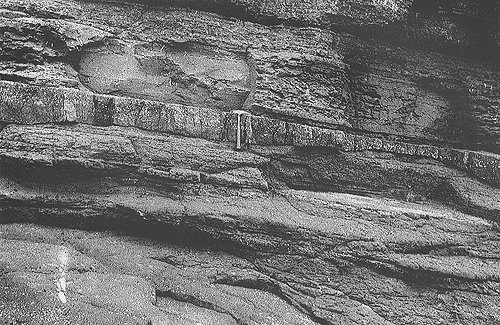
Erosional surface at base of a crevasse deposit
Plate 72

Erosional surface at base of a crevasse deposit
Plate 72
This outcrop shows red colored continental deposits (red beds) belonging to the Devonian Old Red Sandstone Formation of NW Europe. Parallel bedded siltstones constitute the greatest part of it. An isolated bed of pebbly sandstone is intercalated; its thickness changes laterally, the top is flat and the base oblique to the general bedding attitude.
All beds represent fluvial sediments deposited outside channels: the siltstones are overbank deposits, settled from suspension in water that invaded a floodplain after spilling over levees and banks. The sandstone is too thin to be the fill of a channel; it is, more probably, a crevasse splay, i.e., bed load sediment that got out of the channel through a breach in a levee (see plate 57). Its emplacement was preceded by scouring of overbank deposits; the basal erosion surface, plus the presence of pebbles in the deposit, suggest that the channel was not too far for the current to have still a high energy.
Notwithstanding the difference in scale with the previous example, the interpretation is basically the same: a catastrophic event (here, a fluvial flood) produced an erosional surface, which was almost immediately mantled by sediment that the same flow transported. Moreover, synchronous erosion occurs at the base of unconfined flows, and has nothing to do with channel erosion. It can be qualified as unconfined, or sheetlike erosion.
In the case illustrated by this outcrop, in Dunmore East, Ireland, the erosional surface was not smooth: it reveals a small-scale topography, with local scours indicated by lateral thickening and thinning if the bed. The scour-and-fill mechanism implies that such surfaces do not remain exposed and cannot be examined in their entirety. It belongs, moreover, to the smoothing (or drowning) model of sedimentation, in contrast to the draping model, which allows a recognition of the buried topography (see plate 58).
| Photo: G. G. Ori 1992./font> |